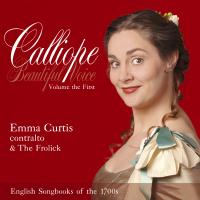
Illusion and Intrigue
English Songbooks
of the 1700s -
reviewed by
GEORGE BALCOMBE'... Baroque charms ...'
|

|
Whatever else the Nine Muses got up to in Classical Greece, one of them, Calliope, indulged
in Epic Poetry. However, by AD 1739 she had moved to London and, doubtless to avoid the
mountains of debt being accrued by every Londoner, she let the music publisher John Simpson
use her name as the title of his new songbook Calliope.
Although the songbook's lyrics are neither so epic nor so poetic as those to which
Calliope had become accustomed in Ancient Greece, they do have at least one advantage over
our Greek muse's word-bound horizons, namely the printed music.
Nevertheless Calliope would definitely have felt at home in late 1730s London among
songs teeming with Nymphs and Shepherds, swooning Swains, and sundry other denizens of
Baroque pastoral landscapes.
Moreover, even now in AD 2006, Calliope continues her inspirational musings. Only
she, feigning a chance encounter, could have brought the long-forgotten songbook
Calliope to the attention of Emma Curtis, a contralto prominent in today's world
of Baroque authenticity.
In the 82-page CD book, Emma Curtis writes 'I was researching the celebrated alto castrato
Senestino when I found Calliope. As I slowly turned its decorated 18th-century pages I
realised that I had in my hands a real treasure, something I was meant to find.'
Exactly. Muse Calliope herself could not have been more explicit.
Songbook Calliope proved to be a treasure indeed, in fact, two treasures. Firstly
the songs
[listen -- CD1 track 14, 1:07-1:50]
and secondly the images of the bizarre milieu surrounding the songs.
Continue >>
Copyright © 6 May 2007
George Balcombe, London UK

| 
